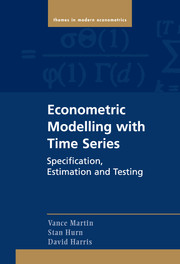Book contents
- Frontmatter
- Contents
- List of Illustrations
- Computer Code Used in the Examples
- Preface
- PART ONE Maximum Likelihood
- PART TWO Regression Models
- 5 Linear Regression Models
- 6 Nonlinear Regression Models
- 7 Autocorrelated Regression Models
- 8 Heteroskedastic Regression Models
- PART THREE Other Estimation Methods
- PART FOUR Stationary Time Series
- PART FIVE Nonstationary Time Series
- PART SIX Nonlinear Time Series
- Appendix A Change of Variable in Density Functions
- Appendix B The Lag Operator
- Appendix C FIML Estimation of a Structural Model
- Appendix D Additional Nonparametric Results
- References
- Author Index
- Subject Index
8 - Heteroskedastic Regression Models
from PART TWO - Regression Models
Published online by Cambridge University Press: 05 January 2013
- Frontmatter
- Contents
- List of Illustrations
- Computer Code Used in the Examples
- Preface
- PART ONE Maximum Likelihood
- PART TWO Regression Models
- 5 Linear Regression Models
- 6 Nonlinear Regression Models
- 7 Autocorrelated Regression Models
- 8 Heteroskedastic Regression Models
- PART THREE Other Estimation Methods
- PART FOUR Stationary Time Series
- PART FIVE Nonstationary Time Series
- PART SIX Nonlinear Time Series
- Appendix A Change of Variable in Density Functions
- Appendix B The Lag Operator
- Appendix C FIML Estimation of a Structural Model
- Appendix D Additional Nonparametric Results
- References
- Author Index
- Subject Index
Summary
Introduction
The regression models considered in Chapters 5 to 7 allow for the mean of the distribution of the dependent variable to vary over time by specifying the mean as a function of a set of exogenous variables. An important feature of these models is that the mean is specified to be time-varying but the variance is assumed to be constant, or homoskedastic. A natural extension of homoskedastic regression models, therefore, is to specify the variance as a function of a set of exogenous variables thereby allowing the variance to be time-varying as well. This class of model is referred to as the heteroskedastic regression model.
In this chapter, the maximum likelihood framework is applied to estimating and testing the heteroskedastic regression model. More general models, in which both heteroskedasticity and autocorrelation structures are present in systems of equations by combining the variance specifications of this chapter with the autocorrelation specifications of Chapter 7, are also considered. In specifying this class of model, the parametric form of the distribution of the disturbances is usually assumed to be normal but this assumption can also be relaxed.
As with the autocorrelated regression model, estimators and testing procedures commonly applied to the heteroskedastic regression model are shown to be special cases of the maximum likelihood framework developed in Part ONE. The estimators that are discussed include weighted least squares and zig-zag algorithms, while the tests that are covered include the Breusch-Pagan and White tests of heteroskedasticity.
- Type
- Chapter
- Information
- Econometric Modelling with Time SeriesSpecification, Estimation and Testing, pp. 272 - 304Publisher: Cambridge University PressPrint publication year: 2012



